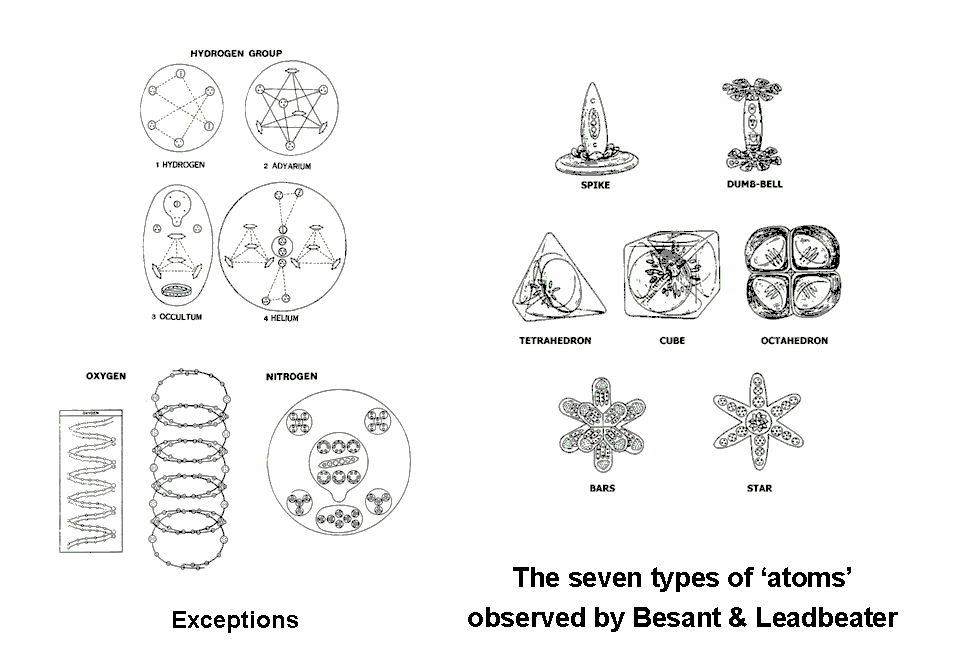
| << Previous 1 2 [3] 4 5 ...13 Next >> |
Micro-psi atoms
As they began their investigations with their micro-psi vision, Besant & Leadbeater soon found that different
specimens of the same chemical compound were composed of similar objects. They naturally assumed that these
structural units, or micro-psi atoms, were ordinary atoms in their normal state, undisturbed by the act of
random selection and observation. They classified MPAs according to their shape into seven groups titled: spike,
dumb-bell, tetrahedron, cube, octahedron, bar and star. They found
that the shape of an MPA was correlated with the position of its corresponding element in the periodic table, i.e.,
all elements in the same group of the table (and having therefore similar chemical properties) had MPAs with
similar kinds of shapes. For example, group 3 elements had MPAs belonging to the cube group and the inert gases had
star-shaped MPAs. Because only four elements (hydrogen, helium, nitrogen and oxygen) did not fit their scheme of
classification, Besant & Leadbeater were able to use this correlation to check their identification of
MPAs.

Apart from these anomalous cases, the MPAs of elements consisted of symmetrically arranged groups of particles bound together in such rapid, complex orbital motion that they presented initially only a blurred, unfocussed image. Throughout the investigations, Leadbeater specialized in the study of the arrangement of their constituents and in identifying and counting their numbers, whilst Besant examined the configuration of the "lines of force" linking and holding together groups of particles and how these configurations changed when she used the psychokinetic faculty accompanying micro-psi to break up these groups into smaller ones. Leadbeater could adjust the magnifying power of his micro-psi vision over a wide range, and this enabled him to resolve images of particles into clusters of "points of light," each of which he resolved further into discrete, 3-dimensional objects. All MPAs consisted of these basic building blocks, which were called ultimate physical atoms (UPAs). The Theosophists also referred to them as 'anu,' this being the Sanskrit word for 'atom.'
The UPA
Just as chemists have found some molecules exist in left-handed and right-handed forms, one the mirror image of the other, so the two Theosophists noticed two chiral varieties of the UPA. It consists of ten non-touching closed curves they called 'whorls' that spiral downwards side-by-side either clockwise ('positive UPA') or anticlockwise ('negative UPA'), making 2½ revolutions about its spin axis, then split at the lowest point into strands of three and seven whorls that spiral upwards 2½ times in opposite
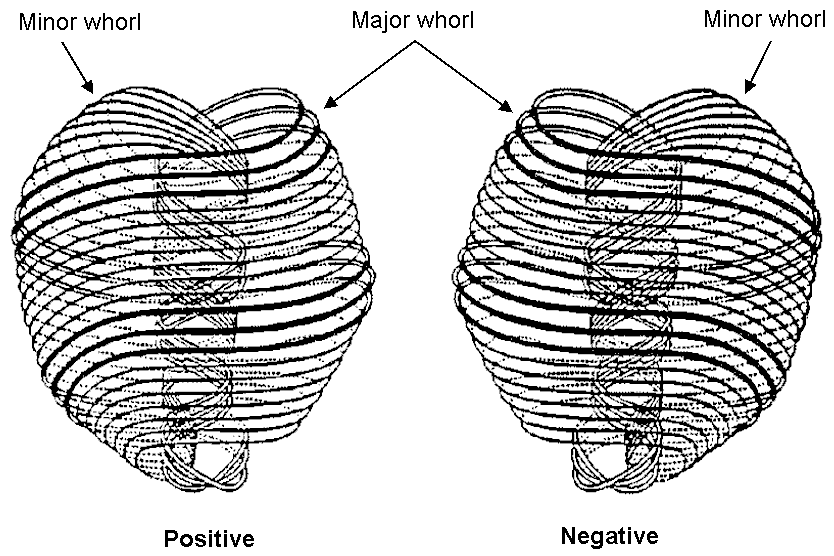
directions, making an inner, narrower helix
as they return to the top of the UPA. A set of three whorls, called "major whorls," appeared to Leadbeater to be
brighter and thicker than the seven other "minor whorls." Each whorl makes five revolutions, the ten whorls
twisting fifty times around the axis of the positive or negative UPA. Its top is open and depressed inwards
slightly, making the particle heart-shaped. It pulsates and spins rapidly about its axis, which also precesses
about the vertical, giving the UPA the wobbling motion of a spinning top. Whilst doing this, one of the minor
whorls may vibrate 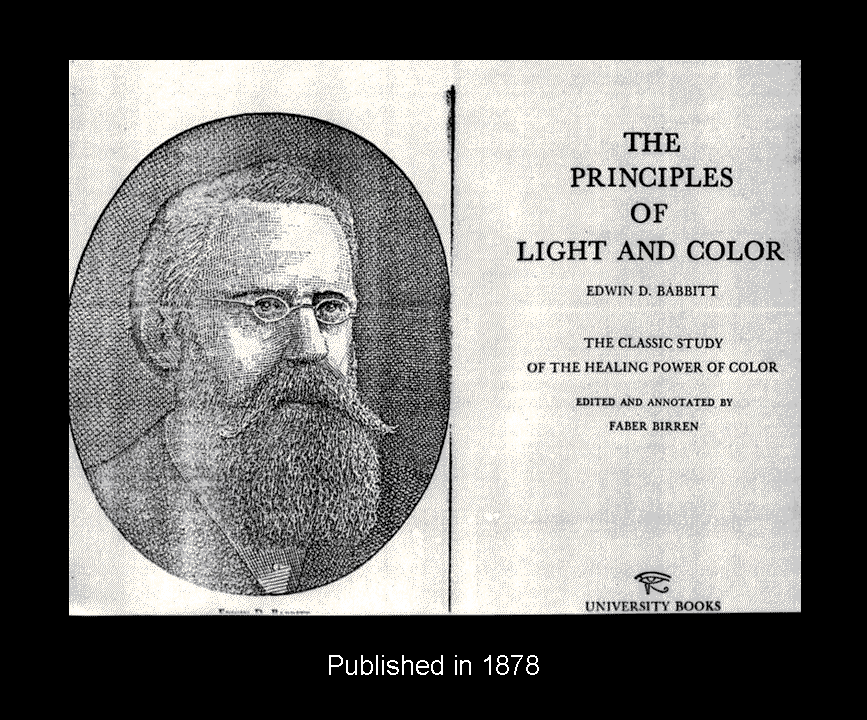 more actively than the others and radiate what appeared to Besant & Leadbeater to be "shades
of colour" that change as one whorl after another becomes active. Lines of force flow into the depression at
the top of the UPA and emanate from its lower, pointed end, being "changed in character by its passage." These
lines of force bind groups of UPAs together in ways which will be described later.
more actively than the others and radiate what appeared to Besant & Leadbeater to be "shades
of colour" that change as one whorl after another becomes active. Lines of force flow into the depression at
the top of the UPA and emanate from its lower, pointed end, being "changed in character by its passage." These
lines of force bind groups of UPAs together in ways which will be described later.
Those who are sceptical about the Occult Chemistry investigations conveniently ignore the fact that Besant & Leadbeater were not the first to publish this description of the building blocks of matter. The picture they gave of it is remarkably similar to a diagram that appeared in a book published thirty years earlier in 1878 called "Principles of Light and Color." It was written by Edwin D. Babbitt (1828-1905), who was one of the most influential American pioneers and writers in the field of colour research and colour therapy. He, too, claimed to have developed a type of clairvoyance that enabled him to magnify atoms, although he was far more reticent about the visions that inspired his theorizing. Besant & Leadbeater give him his due priority in the matter by mentioning him in the first edition of Occult Chemistry:
"A fairly accurate drawing is given in Babbitt's "Principles of Light and Colour," p. 102. The illustration there given of atomic combinations are entirely wrong and misleading, but if the stove-pipe run through the centre of the single atom be removed, the picture may be taken as correct, and will give some idea of the complexity of this fundamental unit of the physical universe."
Babbitt did not describe MPAs because he
wrongly thought that what he had seen was the chemical atom, instead of its basic constituent. Sceptics, of course,
will want to argue that, as the two Theosophists knew of Babbitt's book, they could have plagiarized his picture,
modifying it somewhat (although for what reason?), afterwards concocting their descriptions of MPAs. However, this
is merely an elaboration of the fraud hypothesis, which has to be rejected (see next page) because it fails to
explain 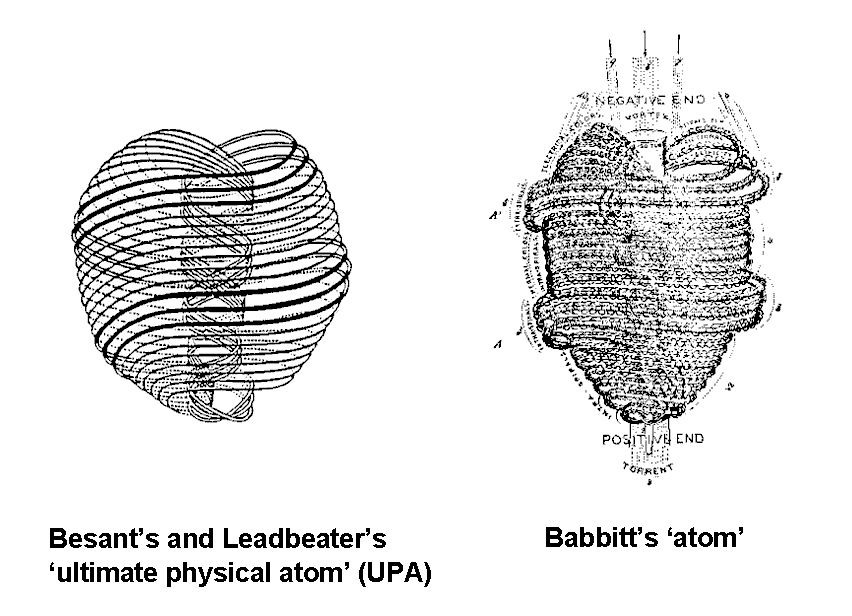
many of the correlations between their observations and facts of nuclear and particle physics, as well as remarkable and undeniable qualitative consistencies with various theories in particle physics, such as the string version of quantum chromodynamics, quark theory and superstring theory, as will be discussed later. These same sceptics, of course, never refer to this huge body of correlations established by the author because it would expose and discredit their naive debunkings. Instead, they pretend that they are unacquainted with it, even though his first three books have been available to the public for several decades. They focus on Besant's & Leadbeater's assumption that they were describing atoms and then use it as an easy target to knock down their claims, at the same time ignoring other logical possibilities, including the one proposed by the author that the two Theosophists studied not atoms per se but objects formed from atoms by the highly disturbing intervention of the micro-psi observer on atomic nuclei that obey the principles of quantum mechanics. This omission, of course, is deliberate, not accidental. Sceptics cannot afford to allow other more sophisticated possibilities that their simplistic debunkings cannot address and dismiss with one easy stroke. So they present the thoroughly dishonest argument that the case for the claim to magnify subatomic particles rests solely on whether MPAs are atoms — as Besant & Leadbeater believed — as though that was the only logical possibility that can be considered. Only the philosophically naive or those prejudiced towards the paranormal will accept this bogus reasoning.
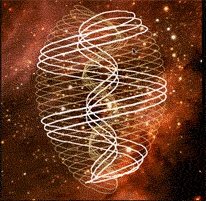
An animation of the UPA
The animation of the UPA shown opposite used to be available at the www.heartcoherence.com
website. It is a good replication, but it perpetuates an error of draftsmanship that was made in the
drawing of the UPA during the preparation of the third edition of Occult Chemistry, which was published
eighteen years after the deaths of its authors. This error went unnoticed by most students of this subject for
many years and remains unnoticed by some of them even today. It is simply that the topmost major whorl was
depicted in that edition (see the diagram above) as being part of the same closed curve as the third
major whorl! If one traces the path of the former, one realises that it crosses over the two other major whorls
at the bottom of the UPA and returns to the top as the third major whorl. This is wrong, because it would imply
that the UPA consists of nine, not ten, closed curves, contradicting what Besant & Leadbeater stated.
Instead of crossing over the two other major whorls, the first major whorl should merely bend at the
bottom into the uppermost curve before it spirals upwards within the central caduceus formed by 2½
complete twists in opposite directions of the set of seven minor whorls and the set of three major
whorls.
A correlation with chemistry
Although many different types of particles were found, some were observed in MPAs of other elements. This fact, together with the geometrical symmetry of MPAs, simplified Leadbeater's task of determining the number of UPAs in an MPA. Instead of having to count every UPA one by one in an MPA that might contain several thousand UPAs, he needed only to count all the groups of UPAs familiar to him through having been observed in other MPAs and then to multiply these numbers by the numbers of UPAs that he had counted in these groups on previous occasions. Every time he noticed a new group, he magnified it and counted its UPAs. Although this procedure saved time and effort, it was a source of systematic error because any error of observation or counting in the original group would lead to a wrong figure for its number of UPAs, and this would be transmitted to all MPAs later found to contain similar groups, thus resulting in a miscalculation of their populations. Despite the potentially distorting influence of this source of error, Besant & Leadbeater discovered, on dividing the UPA population by 18 (the number of UPAs in the simplest MPA — that of hydrogen), that the quotient was always approximately equal to the chemical atomic weight of the element, defined then by scientists as the average weight of the atoms of its isotopes relative to the weight of one hydrogen atom. For example, carbon, whose atomic weight is 12, has 216 UPAs, and 216/18 = 12. This mathematical rule was accurate enough to enable the two investigators to check their identification of an MPA by comparing the calculated quotient: number of UPAs/18 with scientific tables of atomic weights and finding which element provided the best agreement. (It is worth pointing out en passim that the fact that the agreement was only approximate is itself significant because, if the two Theosophists had invented this rule in order to create the bogus impression that their observations were quantitatively consistent with chemistry, their fabricated data would have shown much better agreement with the rule they claimed to have discovered than it actually does. Statistical analysis** of the UPA population data published in the first edition of Occult Chemistry for the 57 elements both examined up till 1908 and known to science then reveals that there is less than one chance in ten thousand that these figures could have been fabricated with the help of a contemporary scientific table of atomic weights mentioned in Occult Chemistry as a source of reference). Besant & Leadbeater believed that the correlation between scientifically determined atomic weights and psychically determined numbers of UPAs in MPAs was an important discovery that linked their clairvoyant observations to science despite all the anomalies and discrepancies they knew their observations had created. So it was, in one sense. Nevertheless, their lack of scientific understanding made them fail to realize that, as it stood, this correlation did not make sense and therefore could not be theoretically significant, as they supposed. An atomic weight does not refer just to one isotope but, instead, is a number averaged over all the isotopes of an element, whereas the number of UPAs in an MPA depends solely on the particular isotope whose atoms happened to be examined and so it cannot be related to a number that is based upon all its isotopes. As we shall see later, this empirical rule discovered by Besant & Leadbeater worked successfully owing to the fortunate fact that the atomic weights of most elements are approximately equal to the mass numbers of their most abundant nuclides — the species of atomic nucleus for a given element that their micro-psi vision was most likely to encounter.
* All diagrams of MPAs are taken from the third edition of Occult Chemistry.
| << Previous 1 2 [3] 4 5 ...13 Next >> |